A Museum on the West Coast devoted to French art deco cars.
Text and photos by Wallace Wyss –
When I first heard there was going to be a museum in Oxnard celebrating French cars, I thought “why only French?” but, after briefly touring it, I can say “Why not?” because there’s enough entertaining (and educational) there to make a visit well worth while.
The Museum is the concept of Peter Mullin, a premier car collector who just happens to have fallen in love with cars of the “streamline modern” era which was in France around 1935 to 1939.
The Museum calls its continuing show L’époque des Carrossiers which well depicts the marriage of automobiles and Art Deco.
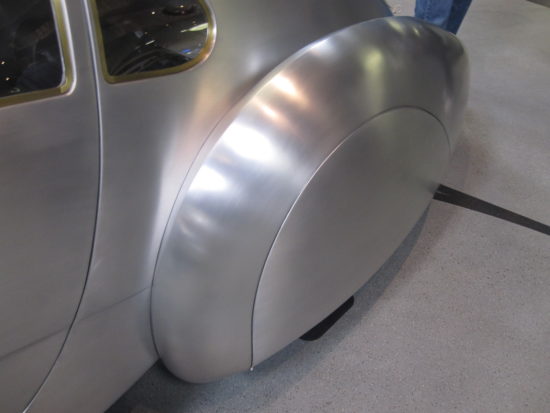
The body designed in modern times to prewar styling shows workmanship you didn’t think anyone could do anymore
Art Deco might be described as an industrial design movement where smoothness of form and celebration of materials was paramount. It even affected such mundane items as vacuum cleaners and tableware but spread to cars where each coachbuilder would endeavor to make their most expensive cars more aerodynamic than the competition.
Now I will admit that it’s mostly a classist phenomenon, on cheap cars there was no budget for elaborate bodywork. But when you came to the expensive brands like Delahaye, Bugatti, Delage, Hispano Suiza and the like where in essence “price was no object” then you see how these cars on display were created. Many customers ordered the cars first by ordering the chassis and then were shown drawings by the carrossiers (custom coachbuilders) and allowed to nit pick on the fender lines, window shapes, trim, etc.
And by the way it is the French that got the concours d’elegances going as a way for buyers of these bespoke cars to show them off, more or less like the Paris Fashion Shows of today, to say “This is the latest.”
There are brands on display at the Mullin that were unknown to me like Voisin. Because Peter Mullin likes all things art deco, he also has some furniture on display, some of it designed by members of the Bugatti family, who were fine artists while Ettore Bugatti built the cars.
This museum reflects Peter Mullin’s belief that the the Art Deco movement is worth remembering because it marks the merging of art and science, which occurred in the late 1920s. Before art had its influence, there were mechanical objects but when art came along there was an effort to marry imaginative design to machines.
Curator Brittanie Kinch says it all began with a very important show, entitled the 1925 Arts Decoratifs exhibit in Paris. She has been quoted saying the 1925 show is what they are trying to bring cultural context to, and I say they succeed.
Among the dozens of cars in the two story display are some standouts that remain in my memory. Here’s a few:
-1937 Talbot-Lago T150 C-SS “Teardrop” coupe by Figoni and Falaschi
This silver 1937 Talbot-Lago T150 C-SS “Teardrop” by Figoni and Falaschiwent on a fast sports car chassis.
Only 14 Talbot-Lago Teardrops were made.
Although it looks too refined to race, a a Teardrop managed a third-place finish in the grueling 24 Hours of Le Mans in 1938.
-1939 Delahaye Type 165 Cabriolet
Open cars are more difficult to make aerodynamic than coupes but this one is very aero for an open car because you can lower the windshield into the body.
Ironically this car was found in America because it had been shipped for display at 1939 New York World’s Fair without an engine, and then impounded after the show when WWII started. It eventually was sold off by customs to a GI and was found in Hawaii with a Cadillac engine on a used car lot. Eventually the original 4.5-liter V-12 engine was found in a German castle and sent to the car it was built for.
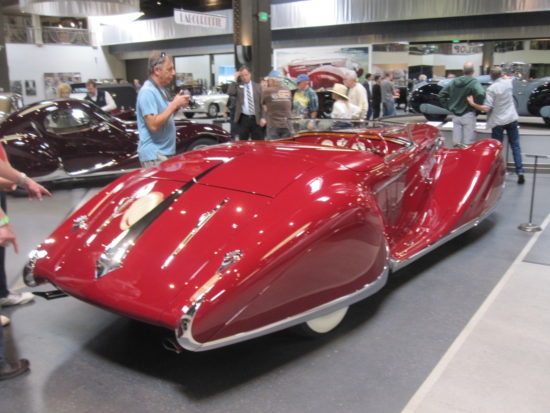
I would say the Delahaye is the crowning glory of the museum. Fortunately it doesn’t have the big nose that a lot of other late ’30s classics have as a result of the whole country going crazy about some whale.
-1936 Bugatti Type 57C Atlantic
Arguably one of the most beautiful automotive designs in history, the Bugatti Atlantic was the production version of Jean Bugatti’s (the son of Ettore) Aérolithe Coupe first shown at the 1935 Paris Auto Salon. When you ask “why does it have a riveted spine?” that can be explained because the lightweight body material—magnesium—is a bear to weld as magnesium is a material that catches fire! So they made the body in two halves and riveted them together along a central spine.
Some of these very special cars had interesting owners, a “who’s who” of society at the time, this one being built for the third Baron Rothschild. Of the four Atlantics built, only two survive in original condition.
-1938 Dubonnet Hispano-Suiza H6B ‘Xenia’
Now this car has such a postwar roofline it’s difficult to believe it is prewar but it is. And like many a famous car it was built for a strong minded person, in this case
Andre Dubonnet, a Renaissance man who was part of the Dubonnet that made aperitifs. He might have been influenced in modern features because he was a pilot, who had a string of aerial victories in World War I’s “Stork” squadron. He was a clever man, smart enough to patent a four-wheel independent “hyperflex” suspension system that automakers making regular production cars, like Alfa Romeo, Fiat, GM, etc. could use.
The body was by one of the most dramatic French coachbuilders Jacques Saoutchik, set upon a Hispano-Suiza chassis he saw at the 1932 Paris Salon. The actual shape was drawn by aircraft and automotive designer Jean Andreau.

There’s a whole row of “derelict” classics, that came from the Schlumph museum in France, a Museum started by two eccentric factory owning brothers who didn’t pay their workers, so obsessed were they about building their car collection.
-1945 Voisin Type C27 Aérosport Coupe
Sometimes you find a car with the wrong body on it, a later one, but when Mullin found this car he knew only two had been built so he had it rebodied to its original configuration.
The Museum has at least two bodies that are partially built, one showing the way coachbuilt bodies were done—a wooden subskelton built to hold the body panels while they were being shaped, which are then removed when the panels were welded in place. One of them has been displayed at the Art Center College of Design a famous school for car designers and probably was the first time design student saw how prewar grand touring cars were designed.

Hey, who said Harley Earl invented the tailfin? Here’s a car designed and built in France before WWII that has a beautiful centrally mounted tailfin that is still looking good today, while the Cadillac tailfins overdid it and can’t be brought back.
One of my favorites was a low slung yellow and black roadster that had a lot of gauges on the dashboard. I think part and parcel of every prewar sports car should be gauges everywhere and this car had them.
The Museum is not open all the time, and has shorter hours than most so I would, if I was making a long journey (it is 1-2 hours from Los Angeles) check open days in advance.
They also have some books for sale and even small artworks containing the side views which are, fundamentally, the way these art deco cars look best.
So, to sum it up, I no longer see a museum devoted just to French cars as too tightly focused. To the contrary, I think all industrial designers, and future car designers, and even fans of art deco should see this display which, though housed in a building that looks like a mundane office building on the outside, is a loving tribute to the French passion for design.
Visit The Mullin Automotive Museum on line here.
Let us know what you think in the Comments.
THE AUTHOR: Wallace Wyss is a fine artist, painting classic car portraits in oil on canvas on commission. For information, write mendoart7@gmail.com.

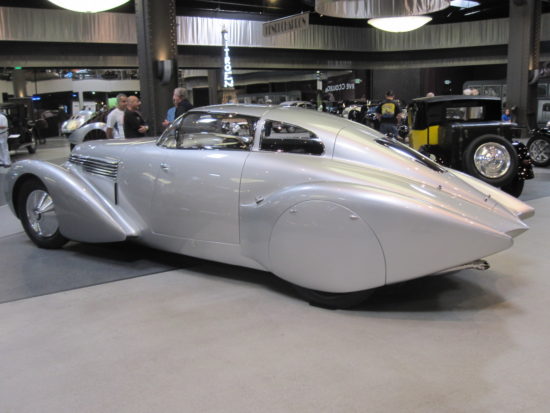

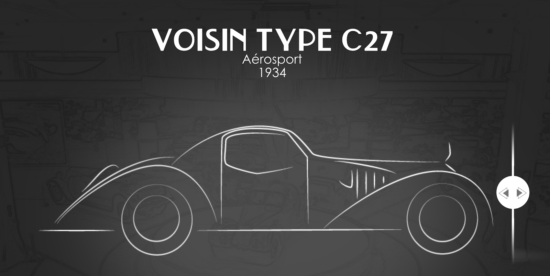
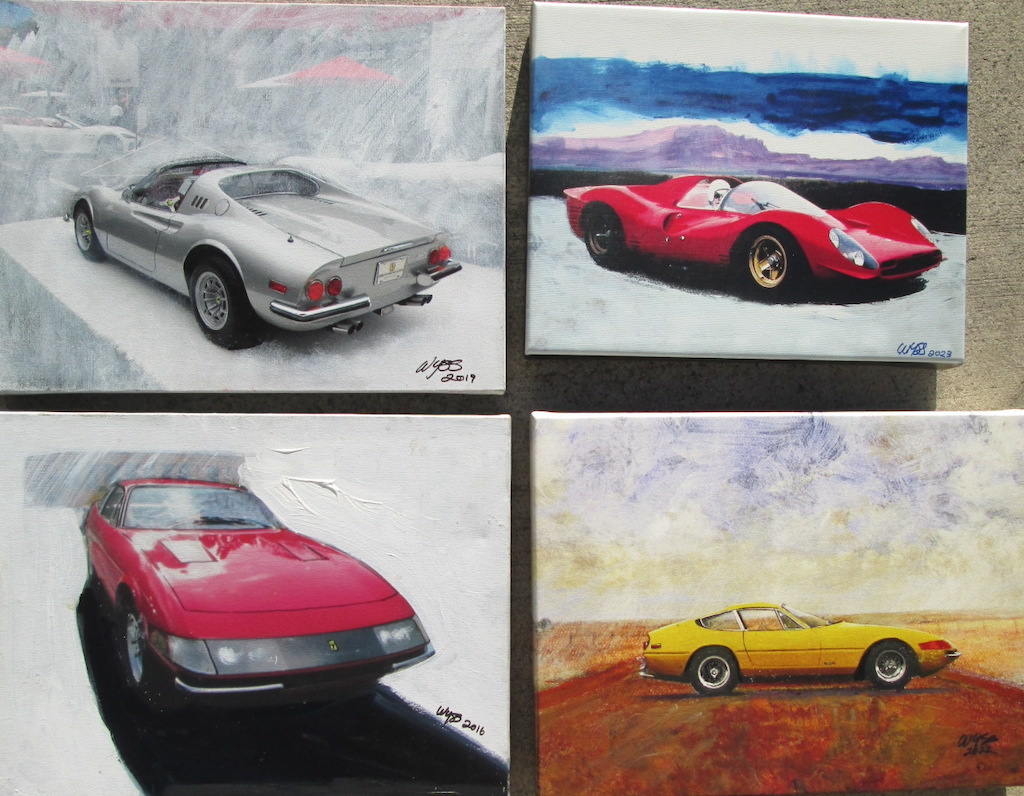

Wallace…. Very nice article on the Mullin Museum. I will need to spend more time in CA to see the new car museums. It’s always good to read someone that does not pretend to “know it all” – as in your admission that you knew nothing about Voisin.
In particular, I really enjoy your fictional stories. By themselves, there is enough for a series of stories – perhaps 30 min deals – much like or Twilight Zone & Black Mirror. You should talk to a producer to look into that. [Loved the one of the ICE getting busted while running up Mullhuland and the race car driver story…]
Part of the purpose of this communication is about the Art Deco design world. It is much deeper than you might realize. Art Deco, as you reported, touched all forms of design, movies, art, – everything. To my tastes, it was the epitome of design – until the late 60′ and 70’s in Italy. Italy – namely Milan and Turino – was the epicenter of haut-design for the world. But Art Deco is the pinnacle!
The Real purpose of this email is about retractable hardtops. As a kid growing up, I thought the 57 Ford retractable hardtop was incredible!! And the 61 though 63 T-Bird soft-top convertible was brilliant. As a student of design and a professional obsessed with it in all forms, I lived with this knowledge for several decades….until some research produced retractable hardtops from the Art Deco era!! Rather than quote chapter & verse on which designers and what cars in what country, I’ll leave that to you to discover for yourself. But it would make a great article for you to write about. I think it interesting to find today’s car designers doing retractable hardtops that are remarkably similar to those of the 1930’s!
Mike Stellato, Architect
AIA, LEED AP, RAS, NCARB Certified
Principal of Star Consulting Group
“Building Sciences Understood”
Architectural / Engineering Firm No. F-20956